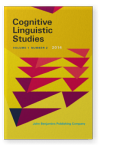A Cognitive Grammar approach to the SLocPAdjC in Mandarin Chinese
Keding Zhang | School of Foreign Languages, Henan University (China)
SLocPAdjC (Locative subject + adjective-predicate construction) is an idiosyncratic construction in Mandarin Chinese. It has its own specific structural and cognitive properties which are different from those of other constructions. Its structural properties are that it has locative phrases as its subject and adjective phrases as its predicate without the help of any linking verb. In addition, only state adjectives, and not property adjectives, can normally occur in SLocPAdjC as predicates. As is observed from the Cognitive Grammar perspective, what the predicate describes in SLocPAdjC is not the subject proper, but a certain facet of the spatial region of the entity designated by the subject. This depends on two cognitive mechanisms. One is the spatial region profiling mechanism of the subject, and the other is the active zone activating mechanism of the predicate. The former means that the signified entity of the nominal phrase in the subject functions as the base. The postposition serves to profile a certain spatial region of the base and makes this region a prominent candidate for the predicate to describe. The latter means that the adjective in the predicate, based on the cognitive domain it belongs to, activates a certain facet of or in the spatial region as the active zone which eventually becomes the actual matter to be described by the predicate. What’s more important, the meaning of the SLocPAdjC in Mandarin Chinese resides in the joint function of the profiling mechanism of the subject and the activating mechanism of the adjective-predicate.
References
Chao, Y.R
(
1968)
A grammar of spoken Chinese. Berkeley: University of California Press.

Croft, W
(
2012)
Verbs: Aspect and causal relations. Oxford: Oxford University Press.

Dik, S
(
1981)
Functional grammar (3rd ed.). Dordrecht: Foris Publications.

Dik, S
(
1997)
The theory of functional grammar, Part 1: The structure of the clause (2nd ed.). Berlin: Mouton de Gruyter.

Fan, K.T., & Zhang, Y.J
(
2000)
Xiandai hanyu yufa fenxi [
Grammatical analysis of modern Chinese]. Shangahi: Huadong Normal University Press.

Fan, X
(Ed.) (
1998)
Hanyu de juzi leixing [
Sentence types of Chinese]. Taiyuan: Shuhai Press.

Fang, J.M
(
2003)
Xiandai hanyu kongjian mingcixing chengfen de zhichengxing [Referentiality of spatial noun phrases in Mandarin Chinese]. In
Zhongguo yuwen zazhishe [Editorial Office of Studies of the Chinese Language]. (Ed.).
Yufa yanjiu yu tansuo (12) [
Studies and explorations in grammar] (pp. 196–209). Beijing: The Commercial Press.

Givón, T
(
1984)
Syntax: A functional-typological introduction (Vol. 11). Amsterdam: John Benjamins.


Goldberg, A.E
(
1995)
Constructions: A construction grammar approach to argument structure. Chicago: The University of Chicago Press.

Hawkins, B.W
(
1984)
The semantics of English spatial prepositions. Ph.D. dissertation. San Diego: University of California, San Diego.
Huang, C.T.J., Li, Y.H.A., & Li, Y.F
(
2009)
The syntax of Chinese. New York: Cambridge University Press.


Jackendoff, R
(
2012)
A user’s guide to thought and meaning. Oxford: Oxford University Press.

Langacker, R.W
(
1984)
Active zones.
Proceedings of the tenth annual meeting of the Berkeley Linguistics Society, 101, 172–188.


Langacker, R.W
(
1987a)
Grammatical ramifications of the setting/participant distinction.
Proceedings of the thirteenth annual meeting of the Berkeley Linguistics Society, 131, 383–394.


Langacker, R.W
(
1987b)
Foundations of cognitive grammar: Theoretical prerequisites (Vol. 11). Stanford: Stanford University Press.

Langacker, R.W
(
1991)
Foundations of cognitive grammar: Descriptive application (Vol. 21). Stanford: Stanford University Press.

Langacker, R.W
(
1993)
Grammatical traces of some ‘invisible’ semantic constructs.
Language Sciences, 15(4), 323–355.


Langacker, R.W
(
1997)
The contextual basis of cognitive semantics. In
J. Nuyts &
E. Pederson (Eds.)
Language and conceptualization (pp. 229–252). Cambridge: Cambridge University Press.


Langacker, R.W
(
1999a)
Grammar and conceptualization. Berlin: Mouton de Gruyter.


Langacker, R.W
(
1999b)
Losing control: Grammaticization, subjectification, and transparency. In
A. Blank &
P. Koch. (Eds.).
Historical semantics and cognition (pp. 147–175). Berlin: Mouton de Gruyter.


Langacker, R.W
(
2008)
Cognitive grammar: A basic introduction. Oxford: Oxford University Press.


Langacker, R.W
(
2009)
Investigations in cognitive grammar. Berlin: Mouton de Gruyter.


Liu, Y.H., Pan, W.Y., & Gu, W
(
2001)
Shiyong xiandai hanyu yufa [
Practical modern Chinese grammar]. Beijing: The Commercial Press.

Qi, H.Y
(
1996)
Biaoshi jingtai weizhi de yizhong lingdongju [A zero-verb sentence expressing static position].
Journal of Nanjing Normal University (Social Science Edition), 31, 125–131.

Qi, H.Y
(
2014)
Xiandai hanyu xianshi kongjian de renzhi yanjiu [
Cognitive studies on the actual space in Mandarin Chinese]. Beijing: The Commercial press.

Saeed, J.I
(
2009)
Semantics (3rd ed.). West Sussex: John Wiley & Sons Ltd.

Shen, J.X
(
1997)
Xingrongci jufa gongneng de biaoji moshi [The markedness model of the syntactic functions of adjectives].
Zhongguo yuwen [
Studies of the Chinese Language], 41, 242–250.

Shi, Y.W
(
1982)
Guanyu mingci he chusuoci de zhuanhua [On the transformation between nouns and locative nouns].
Hanyu xuexi [
Chinese Language Learning], 11, 6–9.

Taylor, J.R
(
2002)
Cognitive grammar. Oxford: Oxford University Press.

Taylor, J.R
(
2012)
The mental corpus: How language is represented in the mind. Oxford: Oxford University Press.


Wen, L
(
1984)
Chusuo, shijian he fangwei [
Place, time and location]. Shanghai: Shanghai Education Press.

Zhu, D.X
(
1956)
Xiandai hanyu xingrongci yanjiu [Studies on modern Chinese adjectives].
Yuyan yanjiu [
Studies in Language and Linguistics], 11, 83–112.

Zhu, D.X
(
1982)
Yufa jiangyi [
Lectures on grammar]. Beijing: The Commercial Press.

Zhu, D.X
(
1999)
Zhu Dexi wenji (2) [
Collected writings of Zhu Dexi]. Beijing: The Commercial press.

Cited by
Cited by 1 other publications
This list is based on CrossRef data as of 1 july 2024. Please note that it may not be complete. Sources presented here have been supplied by the respective publishers.
Any errors therein should be reported to them.
